Bringing CERT and SAR training to Nepal
Dr Behrouz Moghaddasi, a physician from Iran and founder of that country's Search and Rescue Team, is now in Nepal, seeking to improve safety and preparedness by setting up a new institute.
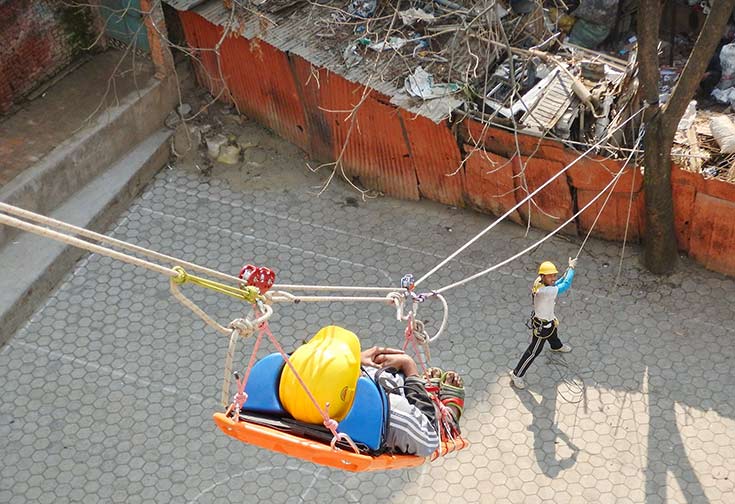
Taking part in the response to the 2015 Nepal earthquake raised a lot of questions in my mind – what more could I do to help?
I started to study the Nepal earthquake when I was in Iran and, eventually, decided to go back to Nepal, arriving in arrived in Kathmandu on October 23, 2015. I began data collection about disaster management and capacity assessment for emergency response to crisis. The goal of my studies was to:
-
Assess disaster management process in Nepal;
-
Find problems and gaps in crisis response; and
-
Suggest a solution.
Vulnerability
Nepal is one of the highly disaster prone countries on the planet and Kathmandu is among the 21 most vulnerable cities in the world. The country’s mountainous and challenging topography and socioeconomic conditions contribute to this vulnerability; a strong earthquake hitting it in the future is a looming possibility.
The lack of awareness of existing risks and their consequences among the general public was shocking. Although in past years, international organisations and the Government of Nepal have collaboratively launched multiple programmes to improve public knowledge, vast gaps still need to be filled before reasonable expectations could be met when disasters occur.
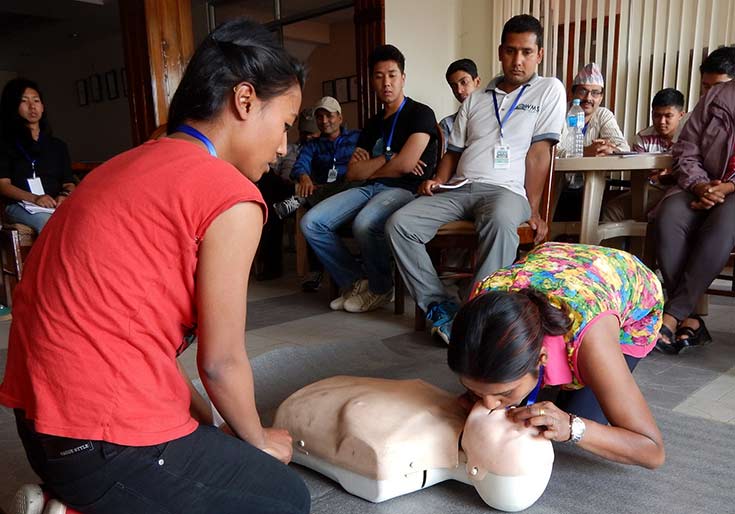
The author has initiated community training programmes in Nepal
Emergency Response Framework
Administratively, Nepal is divided into five regions, 75 districts and around 4,000 villages. For disaster response and emergency management purpose, five Regional Natural Disaster Relief Committees (RNDRC) and 75 District National Disaster Response Committees (DNDRC) supervise emergency response activities in disasters. All RNDRCs and DNDRCs work under the Chairpersonship of Regional and District Administrators. Therefore Nepal's national emergency response framework clearly features central control, regional and local co-ordination. While army personnel, police and the armed police force are the leading first responders, local communities and NGOs are also involved.
Two different groups of stakeholders are critical for future capacity development in Nepal: Government agencies and international and non-governmental organisations.
In times of natural disaster, the Royal Nepal Army (NA) and Nepal Police Forces (NPs) play an important role, especially in carrying out rescue operations. In the event of a large-scale disaster, the Nepal Police establishes command posts to facilitate rescue operations. Police officers collect first-hand information on the event and inform the stakeholders concerned. Moreover, the Police Forces collect most of the data and information on the disaster, and are the key information collector for the rescue operations. Fire brigades are one of the key players in national emergency management system. They are categorised as civil response forces.
Yet there is no professional team trained specifically for disaster management purposes in Nepal. Instead many individuals from different government agencies, have been trained through certain programmes geared towards search and rescue capability development.
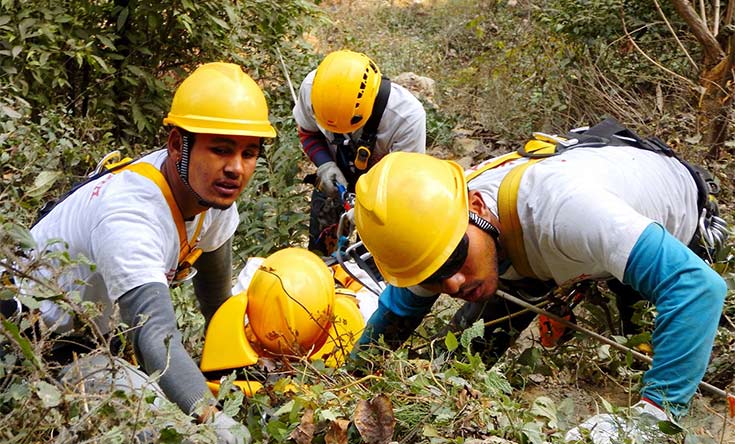
Recognising the need for search and rescue teams in Nepal, the author is conducting training in this area
At the community level, National Red Cross Society (NRCS) is probably the most well equipped organisation that can support community emergency response as well as training.
I realized the NA has been at the core of rescue and relief, but there is clearly an important point: They are not professional rescuers. In my opinion the missing link is that of training and the lack of organised professional rescue teams.
I started to write plan and proposal programmes, in communication with government agencies, international and non-governmental organizations. It was tough, a special style of bureaucracy rules in Nepal. Of course this is normal.
The next step was to start training programmes in a small community. The aim was twofold, to improve community awareness and disaster preparedness, and to conduct professional training in order to launch formal search and rescue teams.
Training courses started in collaboration with several small NGO (for example Jay Nepal). We provided all of courses for free. Most participants were young from all levels of society.
Eventually, together with my friend Hari Dharel, we established the White Mountain Training Institute to provide search and rescue, mountain rescue, disaster preparedness and crisis response training, and humanitarian assistance.
Today, we have a partnership with Himalayan Rescue Association (HRA) and, together with this association, have conducted a Community Emergency Response Team (CERT).
On May 18, we conducted a CERT programme for the Namo-Buddha monastery (a city village 45 km from Kathmandu). At the end of May we will start training and setting up of emergency response team for Kathmandu University. We have another plan in June for launching volunteer search and rescue teams in Kathmandu.
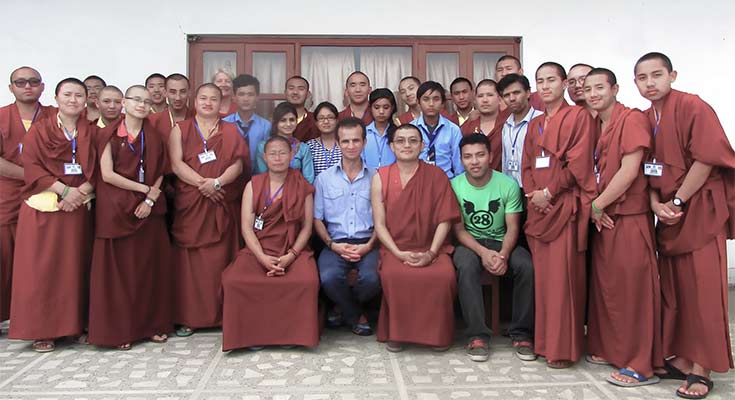
CERT training for the monks at Namo-Buddha monastery, Nepal
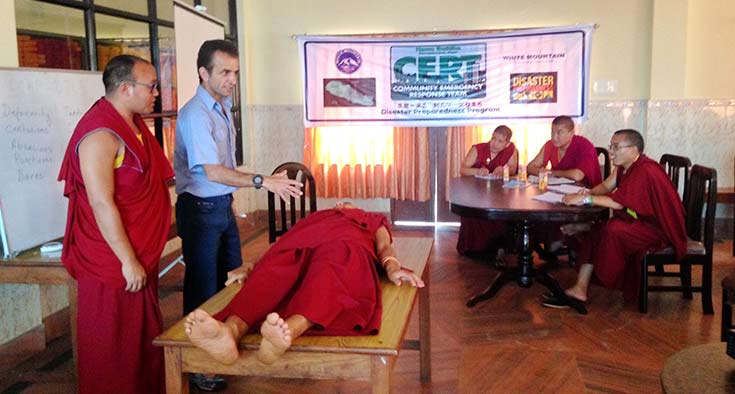
We are satisfied and I believe we are being effective, but much work lies ahead. To date, we have not managed to find a permanent partner among governmental agencies, international and non governmental organisations. Our partnership with the HRA is only in some areas. Of course We could not find a real partner (governmental agencies, International or non-governmental organizations) till now.
But we are trying to find a solution and we will not stop.
Author
Dr Behrouz Moghaddasi, formerly a physician in Iran, established the Iranian Search and Rescue team (ISAR), while training in Wilderness SAR at the Red Crescent university and acting as a Senior Relief and Rescue Officer at the IFRC. He is currently in Nepal, seeking to work on public safety and search and rescue, as outlined above. If any organisations or individuals feel they may be of assistance, please contact Emily Hough, who will be delighted to put you in touch with Dr Moghaddasi.
A more detailed account of this work will be published in CRJ 12:1, September 2016.
Read Dr Moghaddasi’s previous blog Responding to remote areas in Nepal here
Emily Hough interviewed Dr Moghaddasi about his work in Iran for CRJ 10:1
Dr Behrouz Moghaddasi, 24/05/2016